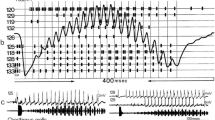Abstract
In grasshoppers the acoustic information for pattern recognition and directional analysis is processed via parallel channels and not serially. This can be concluded from the following results established by behavioural experiments:
-
1.
For pattern recognition the inputs from both sides are added internally. This implies that directional information is lost on this channel and must be processed in parallel.
-
2.
The location of a female song can be influenced by introducing short clicks from both sides, forcing the grasshopper to turn to the louder resp. leading side. Also, when given a choice between two patterns of different efficiency, the grasshoppers turned towards the side with the stronger directional cues and not to the side with the more efficient pattern.
-
3.
The parallel processing of acoustic information in grasshoppers corresponds to the evolution of acoustic communication in Acridids, as song evolved only when the ability of hearing and localization was already present. This is in contrast to crickets where the close evolutionary coupling of singing and hearing in the context of mate finding possibly favoured a serial processing of song recognition and localization.
Similar content being viewed by others
References
Alexander RD (1962) Evolutionary change in cricket acoustical communication. Evolution 16: 443–467
Dirsh VM (1975) A preliminary revision of the families and subfamilies of Acridoidea (Orthoptera, Insecta). Bull Brit Mus (Nat Hist) 10: 349–419
Doherty JA (1985) Trade-off phenomena in calling song recognition and phonotaxis in the cricket, Gryllus bimaculatus (Orthoptera, Gryllidae). J Comp Physiol A 156: 787–801
Doherty JA (1991) Song recognition and localization in the phonotaxis behavior of the field cricket, Gryllus bimaculatus (Orthoptera: Gryllidae). J Comp Physiol A 168: 213–222
Helversen D von (1984) Parallel processing in auditory pattern recognition and directional analysis by the grasshopper Chorthippus biguttulus L. (Acrididae). J Comp Physiol A 154: 837–846
Helversen D von (1993) ‘Absolute steepness’ of ramps as an essential cue for auditory pattern recognition by a grasshopper (Orthoptera; Acrididae; Chorthippus biguttulus L.). J Comp Physiol A 172: 633–639
Helversen D von, Rheinlaender J (1988) Interaural intensity and time discrimination in an unrestraint grasshopper: a tentative behavioural approach. J Comp Physiol A 162: 333–340
Huber F (1987) Plasticity in the auditory system of crickets: Phonotaxis with one ear and neural reorganization within the auditory pathway. J Comp Physiol A 161: 583–604
Huber F, Kleindienst HU, Weber T, Thorson J (1984) Auditory behavior of the cricket. III. Tracking of male calling song by surgically and developmentally one-eared females and the curious role of the anterior tympanum. J Comp Physiol A 155: 725–738
Moiseff A, Pollack GS, Hoy RR (1978) Steering responses of flying crickets to sound and ultrasound: mate attraction and predator avoidance. Proc Natl Acad Sci USA 75: 4052–4056
Otte D (1992) Evolution of cricket songs. J Orthopt Res 1: 24–46
Pollack GS (1986) Discrimination of calling song models by the cricket, Teleogryllus oceanicus: the influence of sound direction on neural encoding of the stimulus temporal pattern and on phonotactic behavior. J Comp Physiol A 158: 549–561
Pollack GS (1988) Selective attention in an insect auditory neuron. J Neurosci 8: 2635–2639
Ronacher B, Stumpner A (1993) Parallel processing of song pattern and sound direction by ascending auditory interneurons in the grasshopper Chorthippus biguttulus L. In: Wiese K, Gribakin FG, Popov AV, Renninger G (eds) Sensory systems of arthropods. Birkhäuser, Basel, pp 376–385
Ronacher B, Helversen DV, Helversen OV (1986) Routes and stations in the processing of auditory directional information in the CNS of a grasshopper, as revealed by surgical experiments. J Comp Physiol A 158: 363–374
Ronacher B, Stumpner A, Helversen OV (1990) Transmission and filtering of behaviourally relevant song parameters by auditory neurons in a grasshopper. In: Gribakin FG et al. (eds) Sensory systems and communication in arthropods. Birkhäuser, Basel, pp 351–358
Schildberger K, Kleindienst H-U (1989) Sound localization in intact and one-eared crickets. Comparison of neural properties with openloop and closed-loop behavior. J Comp Physiol A 165: 615–626
Schmitz B, Scharstein H, Wendler G (1982) Phonotaxis in Gryllus campestris L. (Orthoptera, Gryllidae). I. Mechanism of acoustic orientation in intact female crickets. J Comp Physiol 148: 431–444
Sharov AG (1971) Phylogeny of the Orthopteroidea. Acad Sci USSR, Isr Prog Sci Translat, Jerusalem
Stabel J, Wendler G, Scharstein H (1989) Cricket phonotaxis: localization depends on recognition of the calling song pattern. J Comp Physiol A 165: 165–177
Stumper A, Ronacher B (1991) Auditory interneurons in the metathoracic ganglion of the grasshopper Chorthippus biguttulus. I. Morphological and physiological characterization. J Exp Biol 158: 391–410
Thorson J, Weber T, Huber F (1982) Auditory behaviour of the cricket. II. Simplicity of calling-song recognition in Gryllus, and anomalous phonotaxis at abnormal carrier frequencies. J Comp Physiol 146: 361–378
Weber T, Thorson J (1988) Auditory behavior of the cricket. IV. Interaction of direction of tracking with perceived temporal pattern in split-song paradigms. J Comp Physiol A 163: 13–22
Wendler G (1989) Acoustic orientation of crickets in the presence of two sound sources. Naturwissenschaften 76: 128–129
Wendler G (1990) Pattern recognition and localization in cricket phonotaxis. In: Gribakin FG, Wiese K, Popov AV (eds) Sensory systems and communication in Arthropods. Birkhäuser, Basel, pp 387–394
Wolf H (1986) Response patterns of two auditory interneurons in a freely moving grasshopper (Chorthippus biguttulus L.). J. Comp Physiol A 158: 697–703
Author information
Authors and Affiliations
Rights and permissions
About this article
Cite this article
von Helversen, D., von Helversen, O. Acoustic pattern recognition and orientation in orthopteran insects: parallel or serial processing?. J Comp Physiol A 177, 767–774 (1995). https://doi.org/10.1007/BF00187635
Accepted:
Issue Date:
DOI: https://doi.org/10.1007/BF00187635



